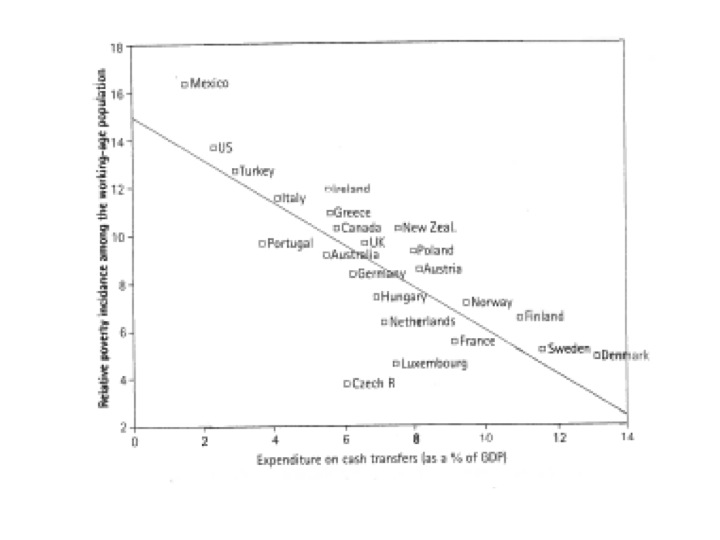 Here's an interesting chart I came across in the course of reading about income inequality. This comes from a paper by Brian Nolan and Ive Marx in the Oxford Handbook of Economic Inequality (Wiemer Salvedra et al. eds. 2009). I found it interesting because it is so, well, plausible. It suggests that, at least among developed countries, poverty rates (measured as people earning less than one half the median national income) decline as governments spend more on cash transfers. [Suggests, but does not prove. It shows a mere correlation. So it could be, for example, (as Nolan and Marx observe) that countries with high transfers also pursue other policies that limit poverty and that it is these policies we should emulate if we want to help the poor.] I think this at least cuts against the more counterintuitive claim made by people like Paul Ryan that slashing government spending on social programs is in the long-term interest of the poor. Ryan wants to argue that he is not a Randian libertarian who is utterly unconcerned with the well-being of the poor. But if he wants to claim that cutting taxes on the rich and gutting Medicare is good for the poor, the burden is on him to show that this is in fact the case and explain how it works. One way to do that would be to show that countries with less generous social spending actually outperform other countries in terms of eliminating poverty. This chart suggests otherwise. (Some will surely argue that, even if government can effectively reduce poverty, the poor in more dynamic, small-government countries will be better off in absolute material terms because they will, over the long run, produce more wealth, which will in turn trickle down to the poorest, etc.. If you compare the countries in the top left of this chart with those in the bottom right, though, I think you will be hard pressed to argue that the countries in the bottom right are underachievers in terms of wealth-production.)The doctrine of subsidiarity says that we leave functions with more local communities unless broader communities can do a better job of accomplishing our goals. A few weeks back, Ryan argued that this doctrine leads him to favor private initiative as a means of combatting poverty:
Here's an interesting chart I came across in the course of reading about income inequality. This comes from a paper by Brian Nolan and Ive Marx in the Oxford Handbook of Economic Inequality (Wiemer Salvedra et al. eds. 2009). I found it interesting because it is so, well, plausible. It suggests that, at least among developed countries, poverty rates (measured as people earning less than one half the median national income) decline as governments spend more on cash transfers. [Suggests, but does not prove. It shows a mere correlation. So it could be, for example, (as Nolan and Marx observe) that countries with high transfers also pursue other policies that limit poverty and that it is these policies we should emulate if we want to help the poor.] I think this at least cuts against the more counterintuitive claim made by people like Paul Ryan that slashing government spending on social programs is in the long-term interest of the poor. Ryan wants to argue that he is not a Randian libertarian who is utterly unconcerned with the well-being of the poor. But if he wants to claim that cutting taxes on the rich and gutting Medicare is good for the poor, the burden is on him to show that this is in fact the case and explain how it works. One way to do that would be to show that countries with less generous social spending actually outperform other countries in terms of eliminating poverty. This chart suggests otherwise. (Some will surely argue that, even if government can effectively reduce poverty, the poor in more dynamic, small-government countries will be better off in absolute material terms because they will, over the long run, produce more wealth, which will in turn trickle down to the poorest, etc.. If you compare the countries in the top left of this chart with those in the bottom right, though, I think you will be hard pressed to argue that the countries in the bottom right are underachievers in terms of wealth-production.)The doctrine of subsidiarity says that we leave functions with more local communities unless broader communities can do a better job of accomplishing our goals. A few weeks back, Ryan argued that this doctrine leads him to favor private initiative as a means of combatting poverty:
To me, the [Catholic] principle of subsidiarity, which is really federalism, meaning government closest to the people governs best, having a civil society of the principle of solidarity where we, through our civic organizations, through our churches, through our charities, through all of our different groups where we interact with people as a community, thats how we advance the common good.By not having big government crowd out civic society, but by having enough space in our communities so that we can interact with each other, and take care of people who are down and out in our communities. Those principles are very very important, and the preferential option for the poor, which is one of the primary tenets of Catholic social teaching, means dont keep people poor, dont make people dependent on government so that they stay stuck at their station in life. Help people get out of poverty out into a life of independence.
This is very confused for reasons others have already noted. The concept of subsidiarity does not map cleanly onto the public/private distinction, since many private communities are not local in any meaningful sense (think WalMart) and some governments are very local. But I think this chart suggests that, even if we took subsidiarity to constitute a preference for private over government solutions, government spending arguably does a very effective job of reducing poverty.
